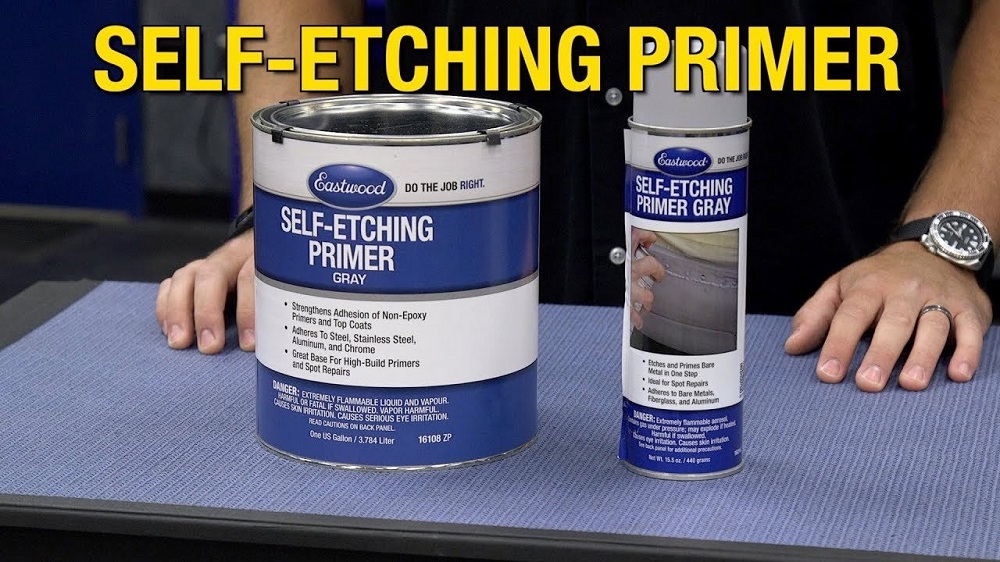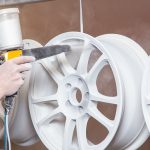In the intricate world of automotive refinishing, where achieving a flawless finish is an art form, the choice of primer plays a pivotal role. Chrome surfaces, with their reflective and smooth characteristics, often present a challenge for adhesion. This prompts the question: Does self-etching primer truly work on chrome? Let’s embark on a comprehensive journey, unraveling the nuances of this query and exploring the intricacies of the process, benefits, and tips for optimal results.
Understanding the Basics
What is Self-Etching Primer?
Before delving into the compatibility with chrome, let’s establish a foundational understanding of self-etching primer. This specialized coating stands out from conventional primers due to its acidic composition. The acid in the primer creates micro-abrasions on the substrate, fostering a stronger bond, and ultimately enhancing adhesion.
The Chrome Conundrum
Chrome, known for its aesthetic appeal, poses a unique challenge. Its non-porous and smooth surface demands a primer that can overcome these inherent characteristics. The quest for a primer that can adhere effectively to chrome surfaces has driven many automotive enthusiasts and professionals to explore the potential of self-etching primer.
The Process Unveiled
Step-by-Step Application
Applying self-etching primer on chrome involves a meticulous process. Begin by thoroughly cleaning the chrome surface to remove any contaminants. The next step is scuffing, a process that promotes adhesion by creating a slightly roughened surface. Once prepared, the primer is applied evenly. The acidic components in the primer facilitate bonding by etching into the chrome.
Drying and Curing
After application, patience becomes a virtue. Allowing sufficient time for the primer to dry and cure is crucial. This step ensures that the primer forms a robust foundation, ready to receive subsequent layers of paint. Rushing this stage may compromise the overall finish.
The Benefits of Choosing Self-Etching Primer
Enhanced Adhesion
The primary allure of self-etching primer lies in its ability to establish a stronger bond with challenging surfaces like chrome. This enhanced adhesion not only contributes to the longevity of the finish but also ensures that the paint adheres securely to the chrome surface.
Corrosion Resistance
Beyond its adhesion prowess, self-etching primers often provide an additional layer of protection against corrosion. This is particularly advantageous for chrome surfaces that are exposed to the elements. The primer acts as a barrier, shielding the chrome from potential damage.
Time Efficiency
In the realm of automotive refinishing, time is a valuable resource. Self-etching primers, with their accelerated bonding mechanism, offer time efficiency. This can be a significant advantage, especially when working on larger projects or in professional settings.
Tips for Optimal Results
Surface Preparation Is Key
The success of self-etching primer on chrome hinges on meticulous surface preparation. Ensuring the chrome surface is thoroughly cleaned and free from contaminants is the first step. Adequate scuffing follows, creating the ideal substrate for the primer to bond effectively.
Even Application Matters
Consistency is paramount during the application of self-etching primer. Uneven coatings may result in adhesion issues, compromising the overall effectiveness of the primer. Taking the time to ensure an even application pays dividends in the final finish.
Compatibility Checks
Not all self-etching primers are created equal. Selecting a primer specifically formulated for chrome surfaces is crucial. Conduct compatibility checks to guarantee that the primer of choice is tailored to adhere optimally to chrome.
Common Concerns Addressed
Can It Be Used on Decorative Chrome?
The prospect of using self-etching primer on decorative chrome raises valid concerns. While the primer can be applied, caution is advised. Testing a small, inconspicuous area is a prudent step to ensure compatibility without compromising the aesthetic appeal of the chrome. (See Also: How to Thin Bondo: Expert Tips for Perfect Consistency)
Is Sanding Necessary?
In some scenarios, light sanding of the chrome surface may be recommended before applying self-etching primer. This step aids in creating micro-abrasions, providing a textured surface for better adhesion. However, the necessity of sanding may vary depending on the specific primer and chrome combination.
Exploring Further Possibilities
Experimentation and Testing
As with any aspect of automotive refinishing, experimentation and testing are invaluable. Different self-etching primers may yield varied results on chrome surfaces. Engage in small-scale tests to discover the ideal combination for your specific project.
Professional Insights
Consulting with professionals in the automotive refinishing industry can offer valuable insights. Experienced painters and technicians often have firsthand knowledge of the challenges associated with chrome surfaces and can provide tailored advice based on their expertise.
Expert Tips for Achieving Optimal Results on Chrome
When it comes to priming chrome surfaces, expertise makes all the difference. Here are some invaluable tips from seasoned professionals to ensure your venture into self-etching primer yields the best results:
1. Surface Preparation Precision
Before applying self-etching primer, devote ample time to surface preparation. Thoroughly clean the chrome, removing any contaminants that could hinder adhesion. Precision in this stage sets the foundation for a flawless finish.
2. Scuffing Matters
Don’t underestimate the importance of scuffing. This step creates micro-abrasions on the chrome, promoting better primer adhesion. Strike the right balance – enough to enhance adhesion, but not too much to compromise the chrome’s integrity.
3. Choose the Right Primer
Not all self-etching primers are created equal. Opt for a primer specifically formulated for chrome surfaces. Compatibility ensures that the primer interacts harmoniously with the chrome, fostering a strong and enduring bond.
4. Even Application is Key
Consistency during primer application is crucial. Uneven coatings may lead to adhesion issues, affecting the overall effectiveness of the primer. Take the time to ensure an even application for optimal results.
5. Patience During Drying and Curing
Rushing the drying and curing process can compromise the entire refinishing endeavor. Allow sufficient time for the primer to cure properly. Patience in this stage pays off in the form of a durable and resilient finish.
6. Test on Decorative Chrome
When dealing with decorative chrome, proceed with caution. Before applying self-etching primer, conduct a small-scale test in an inconspicuous area. Ensure compatibility without sacrificing the visual appeal of the chrome. (See Also: Can You Powder Coat an Engine Block? Exploring Pros, Cons, and Expert Tips)
7. Consider Light Sanding
In certain cases, a light sanding of the chrome surface may enhance primer adhesion. However, this step is contingent on the specific primer and chrome combination. Assess the necessity based on the requirements of your project.
8. Experiment and Adapt
Every project is unique. Embrace experimentation and adapt your approach based on the specific chrome surface and primer combination. Learn from each project to refine your technique for future endeavors.
9. Professional Consultation
When in doubt, seek professional advice. Engage with experienced painters and technicians in the automotive refinishing industry. Their insights can be invaluable, offering tailored guidance based on years of hands-on experience.
10. Quality Over Quantity
Prioritize quality over quantity when applying self-etching primer. A meticulous and well-executed application will yield superior results, contributing to the longevity and visual appeal of the finished product.
Mastering the art of applying self-etching primer on chrome surfaces requires a blend of precision, patience, and adaptability. Incorporate these expert tips into your process to elevate your automotive refinishing endeavors to new heights.
Frequently Asked Questions About Using Self-Etching Primer on Chrome
Navigating the realm of self-etching primer for chrome surfaces can be accompanied by various questions. Let’s address some common queries to provide clarity on this intriguing topic.
1. Can self-etching primer be used on all types of chrome surfaces?
Yes, self-etching primer can be used on most chrome surfaces. However, it’s advisable to test a small, inconspicuous area first to ensure compatibility, especially when dealing with decorative chrome.
2. Is sanding always necessary before applying self-etching primer on chrome?
Sanding is recommended in some cases to create micro-abrasions, promoting better adhesion. However, the necessity of sanding depends on the specific primer and chrome combination. Assess the surface condition and primer requirements for your project.
3. How long should I wait for the self-etching primer to dry and cure on chrome?
The drying and curing time can vary based on environmental conditions and the specific primer used. Generally, it’s recommended to allow ample time, typically 24 hours, for the primer to fully dry and cure before applying subsequent layers.
4. Can self-etching primer be used on chrome parts exposed to the elements?
Yes, one of the benefits of self-etching primer is its corrosion resistance. It provides an additional layer of protection, making it suitable for chrome parts exposed to the elements.
5. How many coats of self-etching primer should be applied on chrome surfaces?
It’s advisable to apply a thin, even coat of self-etching primer on chrome surfaces. Multiple thin coats may be preferable over one thick coat to ensure proper adhesion and a smooth finish. (See Also: What Color Car Fades the Fastest? Exploring Factors and Tips for Long-Lasting Paint)
6. Is self-etching primer a suitable choice for DIY projects on chrome surfaces?
Absolutely. Self-etching primer can be a great choice for DIY projects, provided proper surface preparation and application techniques are followed. It offers an efficient and effective solution for achieving adhesion on chrome.
7. Can self-etching primer be used on chrome wheels?
Yes, self-etching primer can be used on chrome wheels. Ensure thorough cleaning and surface preparation for optimal results. The primer’s enhanced adhesion can contribute to the durability of the finish on chrome wheels.
8. What happens if self-etching primer is not compatible with chrome?
If the primer is not compatible with chrome, it may not adhere properly, leading to issues such as peeling or poor bonding. This emphasizes the importance of conducting compatibility tests before applying the primer on a larger scale.
9. Can I apply regular primer over self-etching primer on chrome?
It’s generally not recommended to apply regular primer over self-etching primer. The self-etching primer is formulated for superior adhesion, and adding another type of primer may compromise its effectiveness.
10. Are there any special considerations when using self-etching primer on chrome in humid conditions?
In humid conditions, drying and curing times may be extended. Ensure proper ventilation and consider using a controlled environment to optimize the application and drying process in humid weather.
Exploring these frequently asked questions provides valuable insights into the nuances of using self-etching primer on chrome surfaces. Whether you’re a seasoned professional or a DIY enthusiast, understanding these aspects enhances your ability to achieve optimal results in your automotive refinishing projects.
Conclusion: Striking the Right Balance
In the quest to determine the efficacy of self-etching primer on chrome, the answer lies in striking the right balance between technique and product selection. When applied with precision on well-prepared surfaces, self-etching primer can indeed be a game-changer in achieving optimal adhesion and a lasting finish on chrome. In the dynamic world of automotive refinishing, embrace the spirit of experimentation, test with confidence, and unlock the transformative potential of this specialized primer for chrome surfaces.



